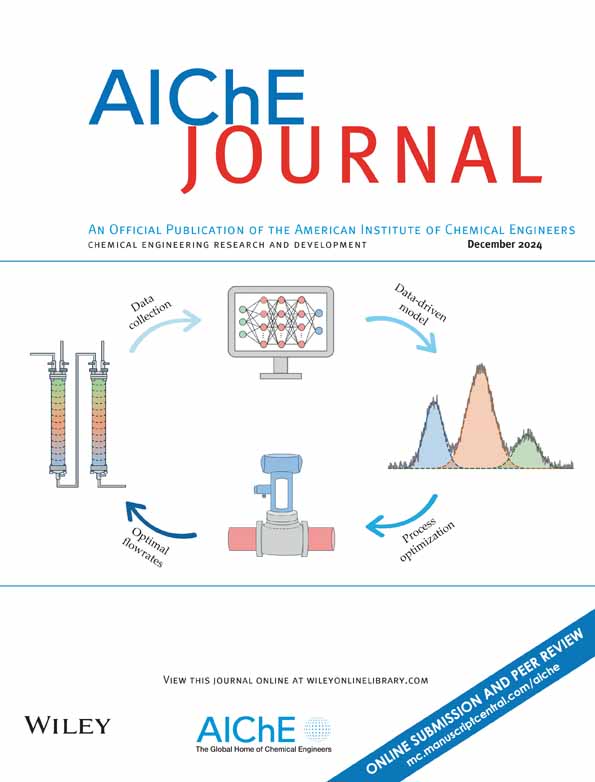Mechanistically guided kinetic analysis of G3-catalyzed ROMP for the precision synthesis of cyclic olefin polymers
IF 3.5
3区 工程技术
Q2 ENGINEERING, CHEMICAL
引用次数: 0
Abstract
Grubbs third-generation catalyst (G3) in ring-opening metathesis polymerization (ROMP) shows unique kinetic behaviors and ligand-addition enabled metathesis activity regulation, while several kinetic features have not been fully revealed. In this work, a thorough kinetic analysis of G3-catalyzed ROMP, for the first time, is carried out via method-of-moments-based numerical simulation and experiments. A generalized kinetic model considering possible metathesis reactions is developed and a stable-deviation-analysis strategy is proposed to estimate the rate coefficient for cyclic monomer propagation. Simulation results confirm that the number of active sites for propagation is independent of the G3 concentration, resulting in the zeroth-order kinetic dependence. Adding external pyridine ligand accelerates the consumption of G3 through a coordination competition, and a positive relation between external ligand concentration and the rate for reaching the steady-state condition is disclosed. The interchain metathesis reaction increases molar mass dispersity by increasing the weight-average molar mass, which can be effectively mitigated by adding a strongly coordinating external ligand. Analysis of ring-chain competition in intrachain backbiting suggests that increasing the initial concentration of reactants can enhance the selectivity for producing linear polymers. This study provides a comprehensive understanding of the mechanism-governed ROMP kinetic behaviors and aids in the precision synthesis of cyclic olefin polymers.g3催化ROMP精密合成环烯烃聚合物的动力学分析
Grubbs第三代催化剂(G3)在开环复分解聚合(ROMP)中表现出独特的动力学行为和配体加成对复分解活性的调控,但一些动力学特征尚未完全揭示。在这项工作中,通过基于矩量法的数值模拟和实验,首次对g3催化的ROMP进行了全面的动力学分析。建立了一个考虑可能的复分解反应的广义动力学模型,并提出了一种稳定偏差分析策略来估计循环单体的速率系数。模拟结果证实,繁殖活性位点数与G3浓度无关,存在零级动力学依赖关系。外部吡啶配体的加入通过配位竞争加速了G3的消耗,并且外部配体浓度与达到稳态条件的速率呈正相关。链间复分解反应通过增加摩尔平均质量来增加摩尔质量分散性,而加入强配位的外配体可以有效地缓解这种分散性。对链内背咬反应中环链竞争的分析表明,增加反应物的初始浓度可以提高生成线性聚合物的选择性。本研究为环烯烃聚合物的精确合成提供了一个全面的机理控制的动力学行为的理解。
本文章由计算机程序翻译,如有差异,请以英文原文为准。
求助全文
约1分钟内获得全文
求助全文
来源期刊

AIChE Journal
工程技术-工程:化工
CiteScore
7.10
自引率
10.80%
发文量
411
审稿时长
3.6 months
期刊介绍:
The AIChE Journal is the premier research monthly in chemical engineering and related fields. This peer-reviewed and broad-based journal reports on the most important and latest technological advances in core areas of chemical engineering as well as in other relevant engineering disciplines. To keep abreast with the progressive outlook of the profession, the Journal has been expanding the scope of its editorial contents to include such fast developing areas as biotechnology, electrochemical engineering, and environmental engineering.
The AIChE Journal is indeed the global communications vehicle for the world-renowned researchers to exchange top-notch research findings with one another. Subscribing to the AIChE Journal is like having immediate access to nine topical journals in the field.
Articles are categorized according to the following topical areas:
Biomolecular Engineering, Bioengineering, Biochemicals, Biofuels, and Food
Inorganic Materials: Synthesis and Processing
Particle Technology and Fluidization
Process Systems Engineering
Reaction Engineering, Kinetics and Catalysis
Separations: Materials, Devices and Processes
Soft Materials: Synthesis, Processing and Products
Thermodynamics and Molecular-Scale Phenomena
Transport Phenomena and Fluid Mechanics.
 求助内容:
求助内容: 应助结果提醒方式:
应助结果提醒方式:


